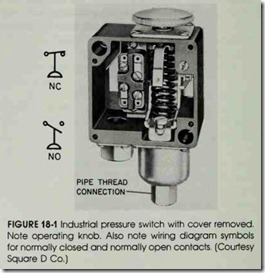Objectives
After studying this unit, the student will be able to:
• Describe how pressure switches, vacuum switches, and pressure regulators may control motors
• List the adjustments that can be made to pressure switches
• Identify wiring symbols used for pressure switches
Any industrial application that has a pressure sending requirement can use a pressure switch, figure 18-1. A large variety of pressure switches are available to cover the wide range of control re quirements for pneumatic or hydraulic machines such as welding equipment, machine tools, high pressure lubricating systems, and motor-driven pumps and air compressors.
The pressure ranges over which pressure switches can maintain control also vary widely. For example, a diaphragm-actuated switch can be used when a sensitive response is required to small pressure changes at low-pressure ranges. A metal bellows-actuated control is used for pressures up to 2000 pounds per square inch. Piston-operated hydraulic switches are suitable for pressures up to 15,000 psi. In all of these pressure controlled de vices, a set of contacts is operated.
The most commonly used pressure switches are single-pole switches. Two-pole switches are also used for some applications. Field adjustments of the range and the differential pressure (or the difference between the cut-in and cut-out pres sures) can be made for most pressure switches.
The spring pressure determines the pressures at which the switch closes and opens its contacts.
Pressure regulators provide accurate control of pressure or vacuum conditions for systems. When they are used as pilot control devices with magnetic starters, pressure regulators are able to control the operation of liquid pump or air com pressor motors in a manner similar to that of pres sure switches. Reverse action regulators can be used on pressure system interlocks to prevent the start of an operation until the pressure in the sys tem has reached the desired level.
Pressure regulators consist of a Bourdon-type pressure gauge and a control relay. Delicate con tacts on the gauge energize the relay and cause it to open or close. The relay contacts are used to control a large motor starter in order to avoid damage or burning of the gauge contacts. Stan dard regulators will open a circuit at high pressure and close it at low pressure. Special reverse oper ation regulators will close the circuit at high pres sure and open the circuit at low pressure.
REVIEW QUESTIONS
1. Describe how pressure switches are connected to start and stop (a) small motors and (b) large motors.
2. Draw the schematic symbol for a pressure switch. Draw both the normally open and the normally closed contact.
